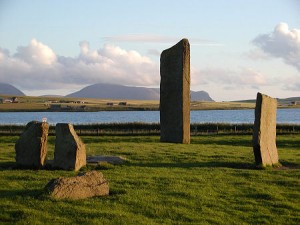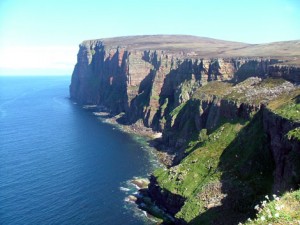
 There’s a rather long list of places I consider high priorities to visit. Near the top of that list is the Orkney Islands. Thanks to some fortuitous circumstances, I’ll be going there at the end of this month. The principle expense is covered, so I will now only have to deal with the loss of income while I’m gone and costs while travelling. It will mean, no doubt, a few cold nights in my backpacking tent, and some creative skimping, but I’m quite used to that sort of thing. My step already has a jaunty skip to it, like my cat does in anticipation of tuna. I know exactly the feeling I’ll have when the plane moves out onto the runway: I’m On the Road Again. This is when I’m happiest, when the game’s afoot, and unguessable adventures lie before me.
There’s a rather long list of places I consider high priorities to visit. Near the top of that list is the Orkney Islands. Thanks to some fortuitous circumstances, I’ll be going there at the end of this month. The principle expense is covered, so I will now only have to deal with the loss of income while I’m gone and costs while travelling. It will mean, no doubt, a few cold nights in my backpacking tent, and some creative skimping, but I’m quite used to that sort of thing. My step already has a jaunty skip to it, like my cat does in anticipation of tuna. I know exactly the feeling I’ll have when the plane moves out onto the runway: I’m On the Road Again. This is when I’m happiest, when the game’s afoot, and unguessable adventures lie before me.
Why Orkney? None of my historian and archaeologist friends need to ask. Less than twenty thousand Orcadians inhabit this cluster of windswept islands north of Scotland, but few places on this planet have the remarkable depth of human remembrance that these little islands have. By comparison, Rome is a trashy modern wannabee, and Canada a fleeting ripple in the river of time. The oldest evidence of human habitation is from about 7000 BC. A Neolithic farmstead dates from 3500 BC, and Skara Brae, Europe’s best-preserved Neolithic settlement, dates from 3100 BC. A freak burial in wind-blown sand kept this astonishing place, with substantial interior furnishings, almost intact. The islands are without timber, so people have built in stone since the earliest times. It is sometimes joked that Orcadians “left the Stone Age in the late 19th century”. The impressive stone circles, contemporary with Stonehenge, are more recent items. The Iron Age left massive stone towers (brochs) and enigmatic Pictish inscriptions. It’s impossible to put across the wonder these places hold for me. The ancient Greek explorer Pytheas of Massilia [Πυθέας ὁ Μασσαλιώτης] seems to have visited in the 4th Century BC, recording the name of Orkas, and the Romans knew the archipelago as Orcades. The name is probably Pictish, and has something to do with pigs. The Vikings, who chased out the Picts and made the islands Norse in culture and language, called it Orkneyar. For centuries, the islands were part of a semi-independent Jarldom or Earldom that balanced precariously between allegiance to the Dano-Norwegian and the Scottish Crowns. Scots English gradually replaced the local Norn language, which died out in the 18th century.
For three hundred years, the Orcadians had an astonishingly intimate relationship with the Canadian Arctic and Subarctic. They intermarried with the native people of Canada, leaving a legacy of Orcadian surnames among the Cree and Métis, who, to this day, preserve Orcadian folk music as a living tradition. That connection is of special interest to me, since I’ve written on the subject [forthcoming from Palgrave Macmillan]. There are local archives of Hudson Bay Company material that I’m eager to plumb.
But leaving aside the intellectual stimulus that the trip will provide, it’s desperately important to me to envigorate my senses with fresh sounds, sights, smells, and textures. Modern Orkney will interest me as much as its ancient monuments, and, unlike most antiquarian visitors, I’m as eager to know the living as the dead. The worst misinterpretations of the past come from having too little feeling for the present, and too little curiosity about the future.
0 Comments.